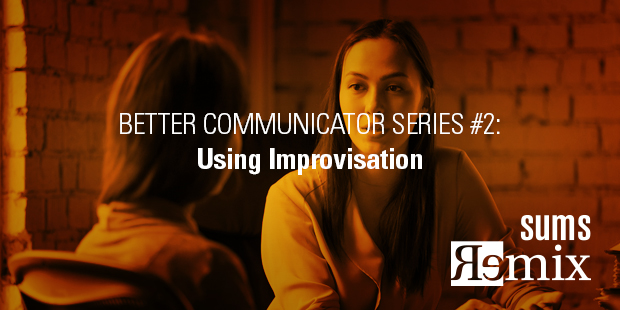
Better Communicator Series #2: Using Improvisation
Let’s face it – many times, our presentations even bore ourselves! Whether leading a meeting, presenting information to a committee, or worst of all, the weekly sermon, how often do you get the sinking feeling you audience is sinking right before your eyes – figuratively, if not literally?
Communication to individuals, to teams, and to large groups is one of the core foundations of the leader’s skill set. And yet, most leaders feel inadequate at times, feeling they are just not connecting.
On top of that, our media-saturated society has an attention span that is growing smaller and smaller, making it difficult to connect, much less persuade, our audience.
Intuitively, as a leader, you know that connecting in person can yield powerful outcomes. Many times it isn’t until you speak to people in person – with one or one hundred or one thousand – that you can establish a visceral connection that motivates them to adopt your idea.
THE QUICK SUMMARY – “Getting to Yes, And” by Bob Kulhan
Amidst the deluge of advice for businesspeople, there lies an overlooked tool, a key to thriving in today’s fast-paced, unpredictable environment: improvisation. In Getting to “Yes And” veteran improv performer, university professor, CEO, and consultant Bob Kulhan unpacks a form of mental agility with powers far beyond the entertainment value of comedy troupes.
Drawing on principles from cognitive and social psychology, behavioral economics, and communication, Kulhan teaches readers to think on their feet and approach the most typical business challenges with fresh eyes and openness. He shows how improv techniques such as the “Yes, and” approach, divergent and convergent thinking, and focusing on being present can translate into more productive meetings, swifter decisions, stronger collaboration, positive conflict resolution, mindfulness, and more. Moving from the individual to the organizational level, Kulhan compiles time-tested teaching methods and training exercises into an instrumental guide that readers can readily implement as a party of one or a company of thousands.
A SIMPLE SOLUTION – Improvising – react, adapt, and communicate
Improvisation should not just be the purview of the comedian onstage. Improvisation, at its most basic level, is about ad-libbing or responding to someone else. When done well, it provides lots of laughter and entertainment. But it can go much further than that.
For many leaders, success requires the ability to create something out of nothing, which in many ways, is what it means to improvise. Think about it; as a leader, haven’t you faced some, if not all, of the following:
- Create partnerships with others
- Develop better processes for your organization
- New ideas for your organization to implement
- Branding or marketing campaigns
- Responses to questions from your team
- Sermon series
- Written content to support your organization
The list goes on and on, and the common thread: you are creating something out of nothing.
Just like improvisation.
Improvisation, when stripped down to its basic building blocks, is about reacting, adapting, and communicating.
Improvisation is not so much a creation of something out of nothing as much as it is the creation of something out of everything – everything one has been taught, everything one has experienced, everything one knows.
Improvisers observe all and try to take advantage of everything around them: every word, every movement, every sound; every facial expression body gesture, moment, and data point. Improvisers will pull from all information at their disposal and will not dismiss anything that might possibly be useful.
A great improviser can look at the tiny details and the big picture simultaneously. Improvisers observe everything for its worth and assess every situation as accurately and honestly as humanly possible.
Bob Kulhan, “Getting to Yes, And”
A NEXT STEP
If a person knows just one thing about the techniques of improv, it’s probably two words: “Yes, and…” This phrase describes the cornerstone philosophy of improvisation.
Each word in the phrase – whether actually spoken or silently implied – represents a key part of the team dynamic and mind-set that must be established between performers. “Yes” represents the unconditional acceptance of an idea that has been presented and established by another performer or group of performers. “And” means that you take that expressed idea and build directly on it.
One of the most powerful components of “Yes, and” is to be aware of not just of what you communicate and how you mean to communicate it, but also of the effect that specific communication has on other people.
Author Bob Kulhan uses the following exercise to lay the groundwork for implementing the “Yes, and” framework into your communication. Use it to begin your journey to “Yes, and.”
Have a three-five minute conversation with a colleague, starting every sentence with “Yes, but…” Focus internally by objectively looking at the language you use after “but,” and focus externally on how the person across from you reacts throughout the course of the entire conversation.
What did you notice?
Now, have a three-five minute conversation with someone, starting every conversation with “Yes, and…” Keep focused internally on your language after “and” and externally on how the person across from you reacts during the entire conversation.
What did you notice?
When you recognize the difference, you will be able to recognize what you are doing in real time so that you can make the choice to continue that behavior or change it to get the desired effect on the people you are influencing.
Excerpt taken from SUMS Remix 107-2, released December 2018.
This is part of a weekly series posting excerpts from one of the most innovative content sources in the church world: SUMS Remix book excerpts for church leaders.
SUMS Remix takes a practical problem in the church and looks at it with three solutions; each solution is taken from a different book. Additionally, a practical action step is included with each solution.
As a church leader you get to scan relevant books based on practical tools and solutions to real ministry problems, not just by the cover of the book. Each post will have the edition number which shows the year and what number it is in the overall sequence. (SUMS Remix provides 26 issues per year, delivered every other week to your inbox).
>> Subscribe to SUMS Remix <<

Tags: Bob Kulhan, Communication skills, Getting to Yes And, Improv, Improvisation














